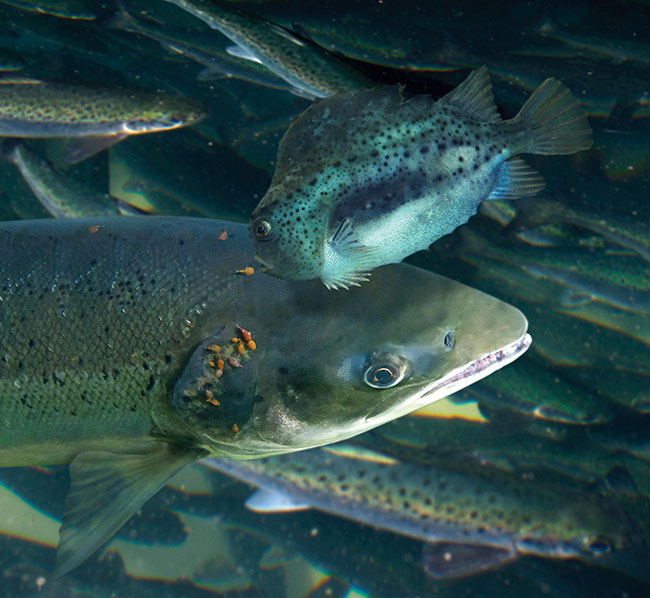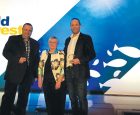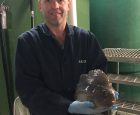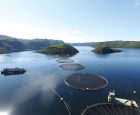
Cleaner-fish production pumped for prime time in Atlantic Canada
September 4, 2019
By Liza Mayer
The stage is set in Atlantic Canada to take innovations in cleaner-fish technology into money-making opportunities
 Credit: Paulo Oliveira/Alamy Stock Photo
Credit: Paulo Oliveira/Alamy Stock Photo Atlantic Canada needs commercial facilities to scale up cleaner-fish technology and produce the roughly five million lumpfish juveniles that the region’s growing salmon industry will require, says Danny Boyce, an academic leading the cleaner-fish initiative in Newfoundland and Labrador, Canada.
Boyce heads the Dr Joe Brown Aquatic Research Building, which is part of the Department of Ocean Sciences at Memorial University in NL, where a cleaner-fish program is based. The program investigates the applications of lumpfish and cunners–both native to Atlantic Canada waters–in salmon aquaculture in the region.
Canada lags behind Norway in the commercialization of cleaner fish as biological weapon against sea lice. “I think we’re really close to moving this species forward to commercialization,” says Boyce. “But to be more secure, and this is my opinion, we need multiple large-scale commercial facilities for the benefit of the industry. We just can’t have all our production coming from one center. And the industry realizes that.”
Big business potential
He says many are recognizing the business opportunities around cleaner fish and are interested in tapping them. “There are various parties looking very closely at potential commercial opportunities. I’m not at liberty to say who or when, but I am confident that before next summer there will be an application put in the system that will make efforts to request to build a nursery facility. It will of course have to go through a regulatory process. This is going to happen very shortly.”
Boyce also believes that a prerequisite for ensuring success in using cleaner fish on a commercial scale is having an ecosystem of service suppliers that will support it. This will include feed, fish health and vaccine developers, transportation services for moving cleaner fish from nursery to farms and suppliers of kelp-like structures (hides) where the cleaner fish hang out.
“Cleaner fish is becoming big business on the east coast of Canada. As the industry matures, people see that they can make money from commercial developments. You will see feed companies make more money with new feed developments, and vaccine companies too. I’m seeing traction now. I’m getting a lot of phone calls, we’re hearing from supply companies that are really interested in what we’re doing here in Atlantic Canada.”
These developments come roughly five years since the cleaner fish initiative started in the region. “Over the last five years we went from raising some fish to raising over a million lumpfish for the industry through our research programs,” says Boyce, who was awarded Aquaculturist of the Year in 2018 by the Newfoundland Aquaculture Industry Association (NAIA).
Industry investment
Aside from Cooke Aquaculture Inc, other clients of Memorial are Mowi Canada East, and Grieg NL. Mowi is field-testing cleaner fish this year. Grieg NL, which is building a $250-million aquaculture project in the province, will field-test lumpfish in the next couple of years, says Boyce.
“These companies are investing in cleaner fish technology at Memorial University. The industry is not going to invest simply in production of cleaner fish, in this case cunners and lumpfish, unless they view it as a valuable tool in their Integrated Pest Management (IPM) strategy. So together we’re putting a lot of attention through research and development,” he says.
The salmon farmers are also providing “room and board” for juvenile lumpfish in their respective nurseries, where they will grow the fish to 25 grams, the typical size when they are ready to be transferred to sea cages and feed on sea lice.
Advertisement
“We’re currently at capacity (at Memorial). We don’t have capacity to raise a million fish to 25 grams, but we’re certainly not full in terms of being able to hold broodstocks, produce eggs and produce one-gram juveniles that go to the nurseries for grow-out,” says Boyce.
Underscoring Memorial’s key role, Boyce adds: “I do caution everybody, and the companies especially, that if we have an issue at Memorial, nobody is getting anything. We have a regional issue. It’s always good to have multiple facilities doing any type of work, whether it is vaccines, feed, fish health, fish hides or furniture companies. You should never rely solely on one company for all your needs.”
Boyce acknowledges that there are still knowledge gaps to address, but these come par for the course with any new technology. “Yes we will always work out feed development. We’ll always work on genetics. We will also always work out vaccine development and fish health challenges. These are things that are supporting the current goals as we move forward right now. But I’m getting some tangibles. I’m getting researchers and grad students interested in moving this forward.”
- The Cleaner Fish Project was honored with the 2018 Excellence in Innovation Award. Danny Boyce (right) of the Department of Ocean Sciences and Sheldon George (left) of Cold Ocean Salmon/ Cooke Aquaculture accepting the award from Dr Laura Halfyard, past president of NAIA
- Danny Boyce holding a 750-gram lumpfish. Boyce estimates Atlantic Canada will need between four to five million cleaner fish over the next five years
- Cooke Aquaculture’s salmon site in NL, a typical farm site where lumpfish are field-tested. In Atlantic Canada, a salmon farm with 700,000 salmon would need around 70,000 cleaner fish, or approximately 10-15 percent of the salmon population All photos courtesy of Department of Ocean Sciences
Green technology
“I can say with honesty that cleaner fish is certainly a very important tool in IPM strategies,” Boyce added. “There are many other tools–chemical therapeutants, the use of different type of nets, heat treatments–every company has its own particular strategy to mitigate sea lice. The results that we’ve seen in the last number of years and the results that we see in the Faroe Islands, in Norway, in the UK, and Ireland, cleaner fish is a green technology, it’s a user-friendly technology. You don’t have to handle and take your salmon off feed, which is an economic benefit.
“The cost of using cleaner fish is a cost-saving measure to other measures if you consider all factors. I don’t think cleaner fish is going to do the job on its own, but as part of the IPM strategy it is certainly a very relevant and valuable tool.”
As part of efforts to advance cleaner fish technology, a working group that includes Boyce, representatives from Cooke, Mowi, Grieg and NAIA, has been conducting workshops over the past two years. The knowledge seminars feature speakers from Canada and overseas who provide crucial insights into emerging trends and future industry advances in cleaner fish technology.
“We’re not interested in just how to raise lumpfish because that’s something we’ve all done in small-scale production; there is nothing new there. But we’re interested in moving the file on new feed developments, vaccines, broodstock development, fish health, cage-site deployment, transportation. So it’s about sharing ideas for the benefit of Atlantic Canada, and Newfoundland in particular.”
The next Global Cleaner Fish Workshop will be held during Cold Harvest 2019 on September 24, 2019 in Salon A of the Delta Hotel, St John’s, NL, Canada. More details can be found at www.ColdHarvest.ca.
- Canada’s Newfoundland emerges as new destination for aquaculture innovation
- Texas drafts rules to boost shellfish farming








